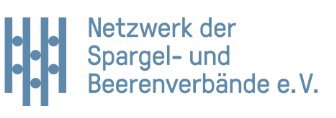Green asparagus with a share of 10 percent can not yet keep up with the still popular white asparagus, but there is definitely a higher demand for green asparagus in Germany, as Frank Saalfeld, Managing Director of the Network of Asparagus and Berry Associations e.V. and Fred Eickhorst, Managing Director of the Association of Asparagus and Berry Growers e.V. tell us. Furthermore, we also talked to both of them about the situation of soft fruit.
Fred Eickhorst and Frank Saalfeld at expoSE 2022
Competition from Italy and Spain
"Green asparagus has the advantage of being very well received, especially by the younger public," Eickhorst knows. ""However, German production also does not benefit from the popularity of green asparagus. After all, the younger generation also buys the green asparagus over twelve months and not only in season. Retailers are reacting accordingly and also offering the product all year round. With white asparagus, on the other hand, we have the problem that our customers are getting older and older. We are fighting like lions to ensure that our customers don't die off as a result," says Eickhorst.
Demand for German green asparagus has nevertheless been good, he says. At the same time, there have been problems with both prices and the fact that Italian and Spanish green asparagus has been sold at cheaper prices for almost the entire season. Eickhorst says, "The price difference with German produce has been so great that domestic green asparagus has been stuck in stores, so some farms have stopped producing even in the middle of the season because the green asparagus couldn't be marketed."
"It's good that green asparagus appeals to the younger audience. At the same time, it's also important to make white asparagus appealing to the younger audience. For example, I see promotions such as grilling asparagus sometimes or preparing it in combination with Parmesan. That's where we need to go stronger. There are already all kinds of possibilities with green asparagus," Eickhorst sums up.
Green asparagus as a "gateway" to white asparagus
Saalfeld also sees the potential of green asparagus to reach a younger target group. "If we want to market German green asparagus as a gateway for a young target group, then we should also dare to establish it more in the direction of 'royalty' again. As it were, the asparagus should also be open to all wallets. In this context, the significantly higher quality of pale asparagus must be made clear, while green asparagus can become the access point to pale asparagus in perspective."
Although purple asparagus is also produced in Germany, it is still a niche product. Nevertheless, says Eickhorst: "Every product that stands out from the crowd has its justification. In berry marketing, we had also seen this several times: There were packages with trays of three, in which three different fruits were placed. That could certainly be applied to asparagus as well."
Development of asparagus like blueberries?
Since German pale asparagus is almost out of competition throughout Europe, Saalfeld sees an opportunity here in marketing. "If we give our asparagus a better image, it will certainly gain a completely different appreciation internationally." He compares this to the situation of blueberries: "Originally, blueberries came from North America and then spilled over to us in Europe. German production developed very well until blueberries suddenly gained a foothold in Peru, and huge areas have been planted in Peru in the last ten years. In retrospect, it can be said that with the decline in sales volumes in Germany, the share of Peruvian product has increased."
At the same time, he said, a story had been spun around blueberries, claiming that they could help against cancer. "This has left clear traces. In addition, Peru has managed to place the product in such a way that it doesn't push directly into the market, but rather follows the season and promptly comes in with large volumes. If you have the will to promote something like that, such a promotion is feasible."
Demand for blueberries exceeds seasonality
Eickhorst adds, "Twelve years ago, 80 percent of the blueberries sold in Germany were homegrown. Now we are at 14-16 percent. However, cultivation has also expanded at the same time. Consumers are also consuming significantly more blueberries than before. There were years when consumers bought more blueberries during the asparagus season than during the actual blueberry season. According to the report, demand goes far beyond seasonality."
In addition, he suspects the same thing will happen to strawberries that has already happened to blueberries and raspberries. "We've never had as many promotional pushes for strawberries in January through March as we've had this year. We even ran promotional pushes for strawberries until the end of November. In previous years, strawberries could not be placed on the market in mid/late August or early September, even though there were enough remontant varieties available. The trade was also not willing to advertise them anymore. Now, however, strawberries are being advertised on a permanent basis. In five years, we'll probably be on the path that blueberries are on."
For more information:
Frank Saalfeld
Netzwerk der Spargel- und Erdbeerverbände e.V.
Ropenstall 83a
51377 Leverkusen
E-Mail: info@netzwerk-spargelbeeren.de
Website: https://netzwerk-spargelbeeren.de
 Fred Eickhorst
Fred Eickhorst
Vereinigung der Spargel- und Beerenanbauer e.V.
Steinstraße 14
26209 Sandhatten
E-Mail: kontakt@spargelundbeerenanbauer.de
Website: https://www.spargelundbeerenanbauer.de
